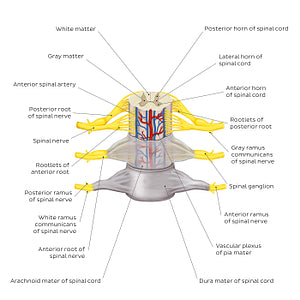Paul Kim
Spinal membranes and nerve roots (English)
Spinal membranes and nerve roots (English)
The pia mater is the innermost layer of the three meningeal layers which surround the spinal cord. It is highly vascular and closely follows the contours of the spinal cord. The second meninx is the arachnoid mater, which is separated from the pia mater by a cerebrospinal fluid filled space known as the subarachnoid space. The thickest and most superficial meninx is the dura mater, which lies in close proximity to the arachnoid mater (but is separated from by a potential space known as the subdural space). The space between the vertebral canal and dura mater is known as the epidural space which contains adipose tissue that helps to absorb shock and protect the spinal cord. The arachnoid and dura mater form a ‘sleeve’ over the spinal nerve rootlets and roots, whereas the pia mater reflects onto the root complex and blends with their epineurium. The dura, arachnoid and pia mater extend along the spinal cord, beyond the conus medullaris to terminate at the lower border of the second sacral vertebra. The anterior spinal root contains motor/autonomic nerve fibers which carry impulses away from the central nervous system (CNS) towards the periphery. The cell bodies of the anterior root neurons are located in the anterior horn of the spinal cord.The posterior spinal root contains the central processes of sensory neurons, whose cell bodies are located in the spinal ganglion of the posterior root of each spinal nerve. They carry signals from the periphery to the CNS. Typically, the anterior and posterior roots unite to form a single spinal nerve carrying mixed motor and sensory fibers and exit the vertebral column through the intervertebral foramina.
Regular price
$7.56 USD
Regular price
Sale price
$7.56 USD
Unit price
per
Couldn't load pickup availability


#F9D20C
#A9695F
#A51912
#5E3246
#FDEC6E
#CCB2AB

